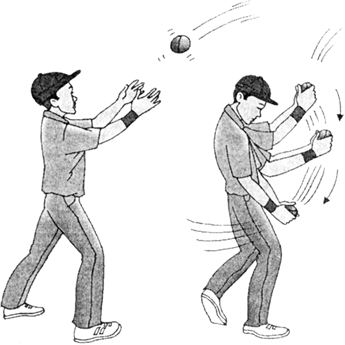State Newton’s first law of motion. Explain it with the help of suitable examples.
Newton's first law of motion states that an object remains in a state of rest or of uniform motion in a straight line unless compelled to change that state by an applied force.
(i) First part, says that a body at rest continues in its state of rest. For example, when a bus suddenly starts moving forward, the person falls backward. This happens because, as the bus moves the lower part of his body begins to move along with the bus while the upper part of his body continues to remain at rest due to inertia. Hence, a person falls backward when the bus starts.
(ii) Second part, says that a body in uniform motion continues moving in straight line path with a uniform speed. For example, when a moving bus suddenly stops, a person sitting inside the bus falls forward. As the bus stops, the lower part of his body comes to rest along with the bus while upper part of his body continues to remain in motion due to inertia and so he falls forward.
(iii) Third part, says that a body moving with a uniform speed in a straight line cannot change itself its direction of motion. For example, when a bus takes a sharp turn, a person sitting in the bus gets a force acting away from the centre of the curved path due to his tendency to move in the original direction. He has to hold on to a support to prevent himself from swaying away in the turning bus.
What is relationship between mass and inertia? Give the SI unit of mass and inertia.
Mass and inertia are correlated. Mass of a body is a measure of its inertia. Both of them are directly related. More massive is the body, larger is the inertia or opposition offered by a body to change its state of motion.
SI unit of mass is kilogram (kg)
SI unit of inertia is kilogram (kg)
Explain how Newton’s second law can be used to define the unit of force. Define the SI unit of force.
Measurement of force from Newton’s second law. Suppose a force F acts on a body of mass m and changes its velocity from u to v in t seconds. Then
According to Newton’s second law, the rate of change of momentum is directly proportional to the applied force, so

where k is a constant. The unit of force is so chosen that k is equal to one. If m = 1, a = 1 and F = 1, then

So a unit force is that force which produces a unit acceleration in a body of unit mass. The S.I. unit of force is newton. One newton is that force which produces an acceleration of 1 m/s2 in a body of mass 1 kg.

Thus, the second law of motion gives us a method to measure force. If the mass and acceleration of a body are known, we can determine the force acting on it.
Define inertia of direction. Give some examples of inertia of direction.
The inability of a body to change by itself its direction of motion is called Inertia of direction.
Examples of inertia of direction:
i) A dog chases a hare, the hare runs along a zig-zag path. It becomes more difficult for the dog to catch the hare because dog has more inertia of direction than that of the hare.
(ii) Consider a stone being rotated at the end of a string in a circle. If the string is suddenly released, the stone flies off tangentially to its circular path.
(iii) As a bicycle moves, the water drops sticking to its tyre start leaving it tangentially.
Give some examples to illustrate Newton’s second law of motion.
(i) A cricket player lowers his hands while catching a ball. By lowering the hands, he increases the time of catching the ball. As a result, the rate of change of momentum decreases and by Newton’s second law, the force exerted on his hands is less. So he is less likely to hurt.
(ii) Chinawares are wrapped in straw paper before packing. The straw paper between the chinawares increases the time of experiencing the jerk during transportation. Hence, they strike against each other with a less force and are less likely to be damaged.
(iii) We are hurt less when we jump on a muddy floor than on a hard floor. When we jump on a muddy floor, the floor is carried in the direction of the jump and the time interval for which force acts is increased. This decreases the rate of change of momentum and hence the force of reaction. Thus, we are hurt less.

